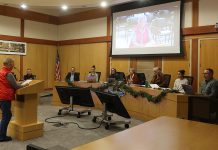Sonoma County grapegrowers who use water to protect crops from
frost will need to register with the county and pay a fee this
month under the terms of a frost protection ordinance finalized
this week by the Sonoma County Board of Supervisors.
The new Vineyard and Frost Protection rules fall short of
hoped-for stream flow monitoring and reporting requirements that
will now be put off until at least next year, under the terms of
the county’s new rules.
Wine industry opposition to implementing a monitoring program
this year “was disappointing,” said 5th District Supervisor Efren
Carrillo.
But growers and regulators, including the National Marine
Fisheries Service (NMFS) and the state Water Resources Control
Board are still working on a monitoring and reporting system that
may eventually make real-time vineyard water use figures available
when spring frost protection efforts are under way.
“We’re still trying to work with the growers,” said
Carrillo.
The new rules require growers who use water for frost protection
to register by March 1 and pay a $64 fee to cover the Sonoma County
Agricultural Commissioner’s cost of administering the registration
process.
The county effort to monitor vineyard operations that use water
for frost protection, including information on individual growers’
water use, comes as a more comprehensive state ordinance is being
written that would ban any pumping of water out of the Russian
River and its tributaries for frost protection unless the vineyard
operator has a state-approved water management plan in place.
The plan would have to demonstrate that the frost protection
operation doesn’t result in a reduction in stream flow that is
harmful to anadromous fish
“What we’re hearing from the state is they’re encouraged” by the
local effort, said Carrillo.
Unusually cold spring weather coupled with drought conditions in
2008 started the ball rolling on stricter frost protection
regulations after “multiple simultaneous” pumping from the River
and creeks by vineyard operations resulted in the stranding deaths
of juvenile fish protected by the federal Endangered Species Act
(ESA).
That’s when the NMFS, tasked with protecting habitat for the
salmon and steelhead listed as threatened or endangered with
extinction in accordance with the ESA, said vineyard frost
protection practices have to be reigned in.
Grapegrowers have been fighting the stricter state rules,
proposing instead to set up the local self-monitoring program that
is now under way.
Some growers, led by Healdsburg’s John Dyson of the prestigious
Williams Selyem Winery on Westside Road, protested the economic
burden Dyson said growers would shoulder if they had to find costly
alternatives for frost protection measures such as wind
machines.
Dyson funded a report by Sonoma State University economics
professor Bob Eyler last year that said the proposed frost
protection regs would bankrupt some small growers, devalue vineyard
land and cause unemployment and shrinking revenues for the county’s
already hurting high-end wine industry.
“I think there’s recognition of the economic impact,” said
Carrillo, after the supervisors agreed last week to a phased-in
ordinance with monitoring and stream flow measurement gauges to be
installed next year.
The board came away from last week’s meeting with the
understanding that Dyson’s group was not “intending to blow up the
ordinance,” said Carrillo.
The state expects to have its regulations in place by 2013 and
“We want to be ahead of the curve,” said Carrillo. “I think the
county now has an opportunity to provide that leadership.”
The new local ordinance requires all frost water protection
users to register with the Agricultural Commissioner prior to March
1 each year. The annual registration process will collect survey
information on “the nature of each frost system infrastructure,
including water diversion infrastructure,” said Sonoma County
Administrator Veronica Ferguson in a report to the board.
“This will include a description of each water source, whether
from a stream, well or recycled. For streams, each point of
diversion will be mapped and the capacity of the diversion will be
given. For wells, the distance from the nearest stream, well depth,
seal depth and diversion capacity will be reported,” said
Ferguson’s report.
Because there will be limited time between adoption and March 1,
the Agricultural Commissioner intends to waive late charges for
registration through June 1, 2011, said Ferguson.
The registration will become the basis for “a system-wide
inventory” of frost water use, to be implemented by the
newly-formed Russian River Water Conservation Council (RRWCC), a
non- profit organization that represents growers in the entire
Sonoma County Russian River watershed, said Ferguson.
This group would fund an independent science review panel to do
data collection, analysis, and reporting.
Dr. Matt Kondolf, a U.C. Berkeley environmental scientist, has
agreed to chair the panel, said Ferguson.
Kondolf was part of a research effort that published a 2009
study of frost protection water diversions in Maacama Creek, a
tributary to the Russian River, that found stream flow reductions
of nearly 100 percent downstream from vineyards during frost
events.
The report said the drop in surface flow water levels lasted
from hours to days and up to an estimated 3.7 million gallons were
extracted.
The entire Maacama drainage network is considered “critical
habitat” for salmon listed as threatened in accordance with the
Endangered Species Act.
The report was used to support a NMFS conclusion that salmonids
are killed by frost water diversions, and are at risk in all major
tributaries with frost protection activities, said the report.
The selection of the review panel members and its operations
“will be consistent with the National Academy of Science’s
protocols for an independent science group, and will not be
influenced by the RRWCC,” said Ferguson.
“While staff continue to support the recommendation of
contracting with the RRWCC, and are prepared to implement the
program in total at this time, communications with representatives
of RRWCC indicate that, due to time constraints and other factors,
it is not feasible to commence implementation of the monitoring
program at this time,” said Ferguson’s report.
“As a result, staff recommend that the implementation of the
monitoring program be phased in over time.”
The phased approach will support program success by allowing the
county to work with the RRWCC, National Marine Fisheries Service,
California Department of Fish and Game, and the State Water
Resources Control Board and environmental stakeholders on
implementation details, said Ferguson.
Through the registration process, the County will have more
detailed information regarding the number of frost water systems in
place, type of systems, and the number of acres in the watershed
protected by frost water methods, said Ferguson.
“With this more detailed information, the implementation of the
monitoring program can be carried out with more precision.
Additional time will allow the County to work with the RRWCC and
the state Water Board to adjust components of the monitoring
program as needed to better conform with the State’s developing
regulations related to frost water use.
County staff will return toward the end of 2011 with
recommendations, including a contract with the RRWCC, monitoring
and reporting fees, and any additional items needed for carrying
out the monitoring plan in time for the 2012 frost season, said
Ferguson’s report.
Staff writer Frank Robertson can be reached at ne**@********st.com.








